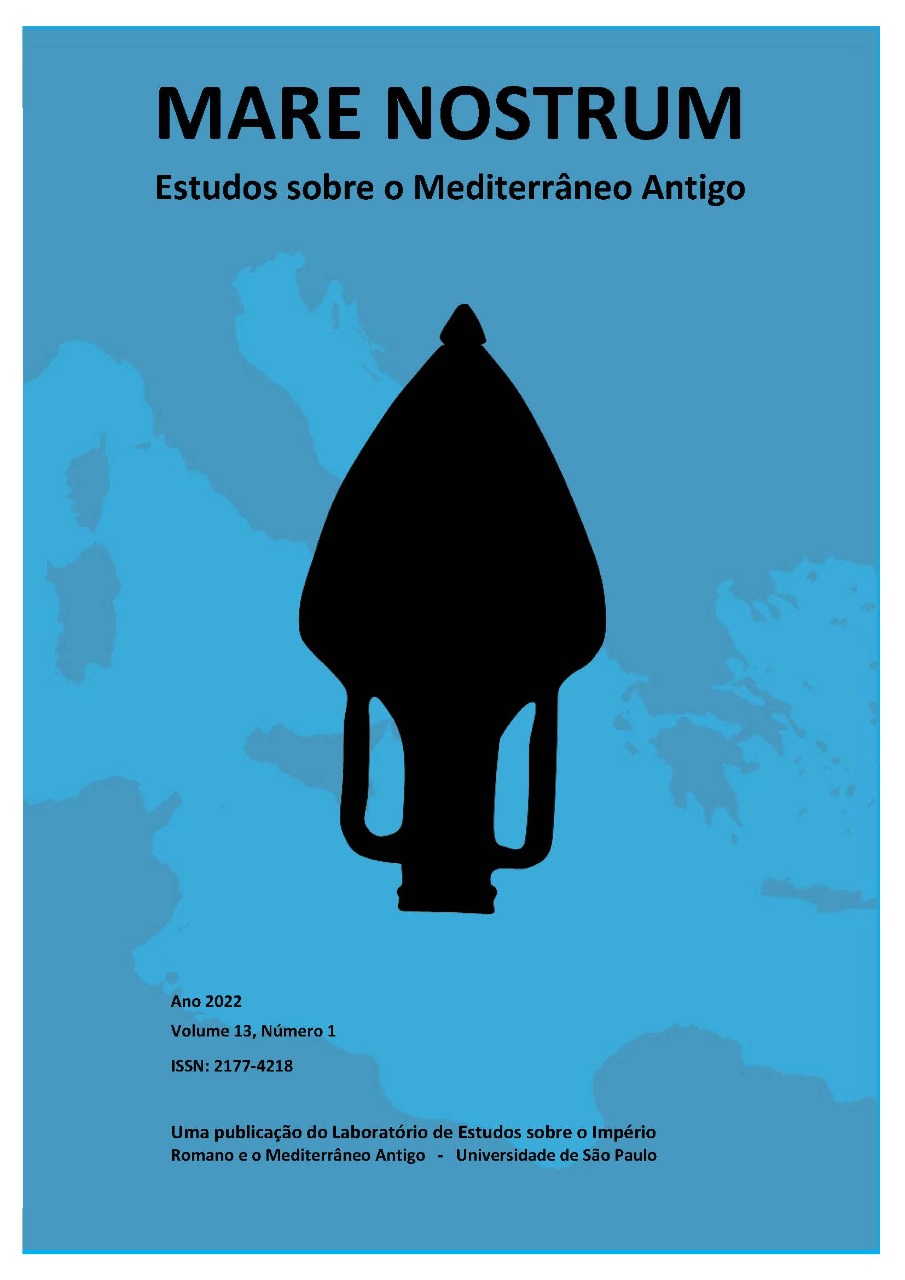Egypt and Egyptology in the Pan-African Discourse of Amy Jacques Garvey and Marcus Garvey
DOI:
https://doi.org/10.11606/issn.2177-4218.v13i1p147-178Palavras-chave:
Amy Jacques Garvey, Marcus Garvey, Gamal Abdel Nasser, pan-Africanism, Egyptology, EgyptResumo
Amy Jacques Garvey and Marcus Garvey argued for the Africanity of ancient Nile Valley cultures, in direct opposition to some academics. In early 20th-century United States, incorrect narratives alleged that Africa had no history. The Garveys, and other Black intellectuals, looked to the Nile Valley to show the absurdity of that claim. The pan-Africanism of Garveyism instilled pride in African descended communities and united them against colonial structures. Pan-Africanism factored strongly in President Gamal Abdel Nasser’s conception of the modern nation-state of Egypt. Egyptian scholars from a variety of fields, including Nile Valley studies, continue to understand ancient Egypt as part of a network of African cultures.
Downloads
Referências
Abdel Nasser, G. (1954). The philosophy of the revolution. Ministry of National Guidance.
Adodo, T. (2021). Translation as a cultural act: An Africological analysis of medew netcher from a Jamaican perspective [Unpublished doctoral dissertation]. Temple University.
Akinsanya, A. (1976). The Afro-Arab alliance: dream or reality. African Affairs, 75(301), p. 511–29.
Beatty, M. H. & Davies, V. (in press). African Americans and the study of Egyptology.
Bernasconi R. (2012). Crossed Lines in the Racialization Process: Race as a Border Concept. Research in Phenomenology 42, p. 206–28.
Boutros-Ghali, B. (1997). Egypt’s road to Jerusalem: A diplomat’s story of the struggle for peace in the Middle East. Random House.
Bowser, A. (1923, January 20). Harvard man on Harvard hate. The Negro World. Reprinted from The Negro Times, 4.
Bruce, J. E. (1923, April 28). King Tut again. The Negro World, 4.
Bust of Pharaoh’s wife discovered in Luxor tomb. (1923, February 17). The Negro World, 5.
Carter, H. (1925, September 28–1926, May 21). TAA Archive i.2.3. Journal, fourth season. Griffith Institute, University of Oxford. http://www.griffith.ox.ac.uk/discoveringTut/journals-and-diaries/.
Challis, D. (2013). The archaeology of race: The eugenic ideas of Francis Galton and Flinders Petrie. Bloomsbury.
Crawford, K. W. (2021). Critique of the “Black Pharaohs” Theme: Racist Perspectives of Egyptian and Kushite/Nubian Interactions in Popular Media. African Archaeological Review, 38, p. 695–712.
Crenshaw, K. (2022). On intersectionality: Essential writings. New Press.
Crowfoot, J. W. (1924). Review of Excavations at Kerma, George A. Reisner (1923). Sudan Notes and Records, 7(1), p. 113–17.
Cuney-Hare, M. (1925, April 1). Letter to W. E. B. Du Bois. W. E. B. Du Bois Papers (MS 312). Special Collections and University Archives, University of Massachusetts Amherst Libraries.
Davies, V. (2018). Egyptological conversations on race and science. Rockefeller Archive Center Research Reports, p. 1–12.
Davies, V. (2019–2020). W. E. B. Du Bois: A new voice in Egyptology’s disciplinary history. ANKH, 28–29, p. 18–29.
Davies, V. (2021). Pauline Hopkins’ literary Egyptology. Journal of Egyptian History, 14(2), p. 127–44.
Davies, V. (Forthcoming). I am no Egyptologist. That goes without saying. Du Bois and the Ancient Nile Valley. Forthcoming.
Drake, St. C. (1991). Black folk here and there: An essay in history and anthropology. (Vol. 1). Center for Afro-American Studies, University of California. (Original volume published 1987).
Du Bois, W. E. B. (2001). Harvard in the Last Decades of the 19th Century. In H. Bloom (Ed.), W. E. B. Du Bois (pp. 5–22). Chelsea House.
Early, G. (1998). Adventures in the colored museum: Afrocentrism, memory, and the construction of race. American Anthropologist, 100(3), p. 703–11.
Ethiopians, not Negroes, claims Harvard professor. (1923, April 21). The Negro World, 3.
Ewing, A. (2014). The age of Garvey: How a Jamaican activist created a mass movement and changed global Black politics. Princeton University Press.
Federal Bureau of Investigation. (n.d.). FBI Records: The Vault, Marcus Garvey. https://vault.fbi.gov/marcus-garvey/marcus-garvey-part-02-of-12/view.
Frankfort, H. (1948). Kingship and the gods. University of Chicago Press.
Garvey, A. J. (1926, July 31). The myth of superior and inferior races. The Negro World, 9.
Garvey, A. J. (1927, May 21). Look to the East! The Negro World, 4.
Garvey, A. J. (1927, November 26). Frenzied attempts to make temperate Africa white. The Negro World, 4.
Garvey, M. (1923, January 20). Are Moroccans and Algerians Negroes? The Negro World, 1.
Garvey, M. (1923, May 5). Blazing the trail of African redemption. The Negro World, 1.
Garvey, M. (with Essien-Udom, E. U.). (1967). The philosophy and opinions of Marcus Garvey (A. J. Garvey, Ed.). (Vols. 1–2). Frank Cass. (Original volumes published 1923, 1925).
Garvey, M. (with Lynch, H. R.). (1968). The philosophy and opinions of Marcus Garvey (A. J. Garvey, Ed.). (Vols. 1–2). Atheneum. (Original volumes published 1923, 1925)
Garvey, M. (with Martin, T.). (1986). The philosophy and opinions of Marcus Garvey, or Africa for the Africans (A. J. Garvey, Ed.). (Vols. 1–2). The Majority Press. (Original volumes published 1923, 1925)
Garvey, M. (2004). Editorial: ‘Who and What Is a Negro?’ In T. Crawford (Ed.), Selected writings and speeches of Marcus Garvey. Dover.
Grant, C. (2008). Negro with a hat: The rise and fall of Marcus Garvey. Oxford University Press.
Hassan, F. (2021, May 11). The African dimension of Egyptian origins. The Nile Valley collective. https://nilevalleycollective.org/african-dimension-of-egyptian-origins/.
Hefny, M. (2019). I am not a white man but the US government is forcing me to be one. Africa World Press.
Hill Collins, P. and S. Bilge (2020). Intersectionality. 2nd ed. Polity.
Ignatiev, N. (1995). How the Irish became white. Routledge.
Ismael, T. Y. (1971). The U.A.R. in Africa. Northwestern University Press.
Jackson Lears, T. J. (1985). The concept of cultural hegemony: problems and possibilities. The American Historical Review, 90(3), p. 567–93.
Jacobson, M. F. (1999). Whiteness of a different color: European immigrants and the alchemy of race. Harvard University Press.
Keita, M. (2000). Race and the writing of history: Riddling the sphinx. Oxford University Press.
Keita, S. O. Y. (1993). Studies and comments on ancient Egyptian biological relationships. History in Africa, 20, 129–54.
Keita, S. O. Y., R. A. Kittles, C. D. M. Royal, et al. (2004). Conceptualizing human variation. Nature Genetics Supplement, 36(11), S17–S20.
Kendi, I. X. (2016). Stamped from the beginning: The definitive history of racist ideas in America. Nation Books.
Kingstone, L. S. (2018). Fading out black and white: Racial ambiguity in American culture. Rowman & Littlefield.
King Tut a Negro. (1923, April 21). The Negro World, 6.
Kosba, M. T. (2021). And bid him sing: Egyptian race consciousness in African diasporic memory. Égypte/Monde arabe, 23, p. 1–16.
Malki, I. P. X. (2017). The competing ontologies of belonging: Race, class, citizenship, and Sierra Leone’s “Lebanese question”. Dialectical Anthropology, 41(4), 343–66.
Mamdani, M. (2001). When victims become killers: Colonialism, nativism, and the genocide in Rwanda. Princeton University Press.
Manuelian, P. Der. (2022). Walking among pharaohs: George Reisner and the dawn of modern Egyptology. Oxford University Press.
Marks, J. (2017a). Is science racist? Polity Press.
Marks, J. (2017b). What it means to be 98% chimpanzee: Apes, people, and their genes. University of California Press.
Martin, T. (1985). The pan-African connection: From slavery to Garvey and beyond. Majority Press. (Original volume published 1983).
Maynard Keynes was right. (1923, January 20). The Negro World, 4.
Minor, E. (2018). Decolonizing Reisner: A case study of a Classic Kerma female burial for reinterpreting early Nubian archaeological collections through digital archival resources. In M. Honegger (Ed.), Nubian Archaeology in the XXIst Century: Proceedings of the Thirteenth International Conference for Nubian Studies, Neuchâtel, 1st–6th September 2014 (pp. 251–262). Peeters.
Mokhtar, G. (1981). Introduction. In G. Mokhtar (Ed.), General history of Africa II: Ancient civilizations of Africa (pp. 1–26). UNESCO Publishing.
Morsy, S. A. (1996). Beyond the honorary “white” classification of Egyptians: Societal identity in historical context. In S. Gregory & R. Sanjek (Eds.), Race (pp. 175–98). Rutgers University Press.
Nascimento, A. do. (1980). Quilombismo: An Afro-Brazilian political alternative. Journal of Black Studies, 11(2), p. 141–78.
Nobles, M. (2000). Shades of citizenship: Race and the census in modern politics. Stanford University Press.
Pendegraft, G. [Kenyatta, M.] (2017). Third World decolonization: The pan African movement in the age of Nasserism [Unpublished master’s thesis]. University of North Texas.
Pendleton, L. A. (1912). Narrative of the Negro. R. L. Pendleton.
Pierce, A. T. (2016, December 2). Justice delayed, but not justice denied, for Marcus Garvey. The Hill. https://thehill.com/blogs/congress-blog/judicial/308453-justice-delayed-but-not-justice-denied-for-marcus-garvey.
Rashwan, H. (2021). Against Eurocentrism: Decolonizing Eurocentric literary theories in the ancient Egyptian and Arabic poetics. Howard Journal of Communications, 32(2), 171–96. DOI: 10.1080/10646175.2021.1879695.
Reisner, G. A. (1910). The archaeological survey of Nubia, report for 1907–1908, volume I. Archaeological report. National Printing Department.
Reisner, G. A. (1915, April). Accessions to the Egyptian Department during 1914. Museum of Fine Arts Bulletin, 13(76), p. 29–36.
Reisner, G. A. (1923). Excavations at Kerma, parts I–III. Peabody Museum of Harvard University.
Roediger, D. R. (2005). Working toward whiteness: How America’s immigrants became white, the strange journey from Ellis Island to the suburbs. Basic Books.
Sharaf Eldin, A. A.-T. (2022, February 22). Egypt’s African identity. Ahram Online. https://english.ahram.org.eg/News/461584.aspx.
Sommer, M. (2005). Ancient hunters and their modern representatives: William Sollas’s (1849–1936) anthropology from disappointed bridge to trunkless tree and the instrumentalisation of racial conflict. Journal of the History of Biology, 38(2), p. 327–65.
Taylor, U. Y. (2002). The veiled Garvey: The life and times of Amy Jacques Garvey. University of North Carolina Press.
The Crisis. (1915, September). [George Reisner’s archaeological work at Giza, reprinted from the Boston (Evening) Transcript], 10(5), 229.
Was King Tut a Negro? (1923, March 24). The Negro World, 4.
Were the Egyptians Negroes? (1923, February 17). The Negro World, 4.
Williams, S. (2021). White malice: The CIA and the neocolonisation of Africa. PublicAffairs.
Williams, V. J., Jr. (2018, Fall). Review of Ibram X. Kendi, Stamped from the beginning: The definitive history of racist ideas in America. (2016). The Journal of African American History, 103(4), 720–721. https://doi.org/10.1086/700230
Woodson, C. G. (2005). The mis-education of the Negro. Dover. (Original volume published 1933).
Downloads
Publicado
Edição
Seção
Licença
Copyright (c) 2022 Vanessa Davies

Este trabalho está licenciado sob uma licença Creative Commons Attribution 4.0 International License.
Os conteúdos expressos nos textos publicados pela Mare Nostrum são de exclusiva responsabilidade de seus respectivos autores.
A reprodução dos textos editados pela Mare Nostrum é permitida sob licença Creative Commons, Atribuição-NãoComercial (CC BY-NC).
Autores que publicam nesta revista concordam com os seguintes termos:
- Autores mantém os direitos autorais e concedem à revista o direito de primeira publicação, com o trabalho simultaneamente licenciado sob a Licença Creative Commons Attribution que permite o compartilhamento do trabalho com reconhecimento da autoria e publicação inicial nesta revista.
- Autores têm autorização para assumir contratos adicionais separadamente, para distribuição não-exclusiva da versão do trabalho publicada nesta revista (ex.: publicar em repositório institucional ou como capítulo de livro), com reconhecimento de autoria e publicação inicial nesta revista.
- Autores têm permissão e são estimulados a publicar e distribuir seu trabalho online (ex.: em repositórios institucionais ou na sua página pessoal) a qualquer ponto antes ou durante o processo editorial, já que isso pode gerar alterações produtivas, bem como aumentar o impacto e a citação do trabalho publicado (Veja O Efeito do Acesso Livre).









